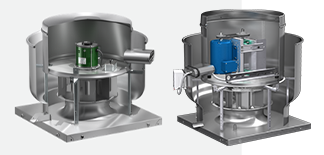A restaurant’s circumstances often fluctuate in response to customer needs and wants, changes in cooking methods, new distribution processes or more unpredictable events due to economic or public health conditions like COVID-19. These inevitable transformations provide the opportunity to optimize your commercial kitchen ventilation system for flexibility to adapt and thrive in new conditions. Now more than ever it is critical for commercial kitchen ventilation systems to be equipped with flexible components that adapt to operational changes and energy usage that can be optimized – helping restaurants control costs, remain competitive and maintain safety during the pandemic.
One critical component of commercial kitchen ventilation flexibility is a variable volume control system that can sense the cooking load and tailor the exhaust and supply airflow to meet demands. Equipping the restaurant with an exhaust fan and make-up air unit that have a wide range of airflow modulation can help establishments remain efficient through changes in cooking volume, adjustments in the style of food cooked, or changes in cooking equipment underneath the commercial hood which may change the amount of airflow required.
Newer, more efficient motor technology makes it possible to adjust exhaust fan speeds according to changing needs. To achieve the greatest flexibility and highest energy savings, the ideal exhaust fan would have an electronically commutated motor (ECM). Fans with this type of motor have easy speed control via an integral dial or signal from the kitchen control that can accommodate a wider range of automatic airflow adjustment. Fans with an ECM also provide added benefits and savings by lasting longer and requiring less maintenance than traditional motor equipped fans.
To balance the kitchen appropriately and control costs, it is crucial to select a make-up air unit that can adjust both airflow and tempering capability to accommodate a variety of airflow demands. Properly configuring the unit will enable it to reach its full efficiency potential. Direct gas-heated make-up air units should be configured to adequately maintain their velocity across the burner as airflow increases or decreases. Packaged DX cooled make-up air units should be equipped to handle fluctuating airflow without freezing the coil, which could cause damage to the unit and limit the cooling ability needed from the unit. Select a unit with at least 50% turndown capability and cooling that starts as soon as the temperature rises above 75° F.
To further optimize the efficiency and cost savings of a flexible commercial kitchen ventilation system, small changes and enhancements can also be made to other components. Using LED lights in the exhaust hood instead of standard incandescent bulbs can save up to 95% in lighting utility costs. This small change can incur noticeable savings over time as hood lights are typically left on at all times. Another commercial kitchen ventilation best practice that ensures efficiency and cost savings is capturing more grease at the cooking source with improved hood filtration.
During a pandemic, higher amounts of fresh air and air exchanges are recommended to improve indoor air quality considering virus transmission. This creates greater difficulty in keeping a kitchen or restaurant conditioned properly. But optimizing your ventilation system to accommodate a wide range of airflow increases your preparedness as situations and guidelines adapt. Accurex’s team of experts is always available to assist with any ventilation questions or concerns you may have. To speak to a team member about your restaurant ventilation needs, reach out to us here .







